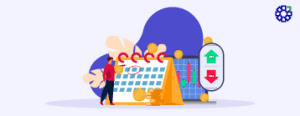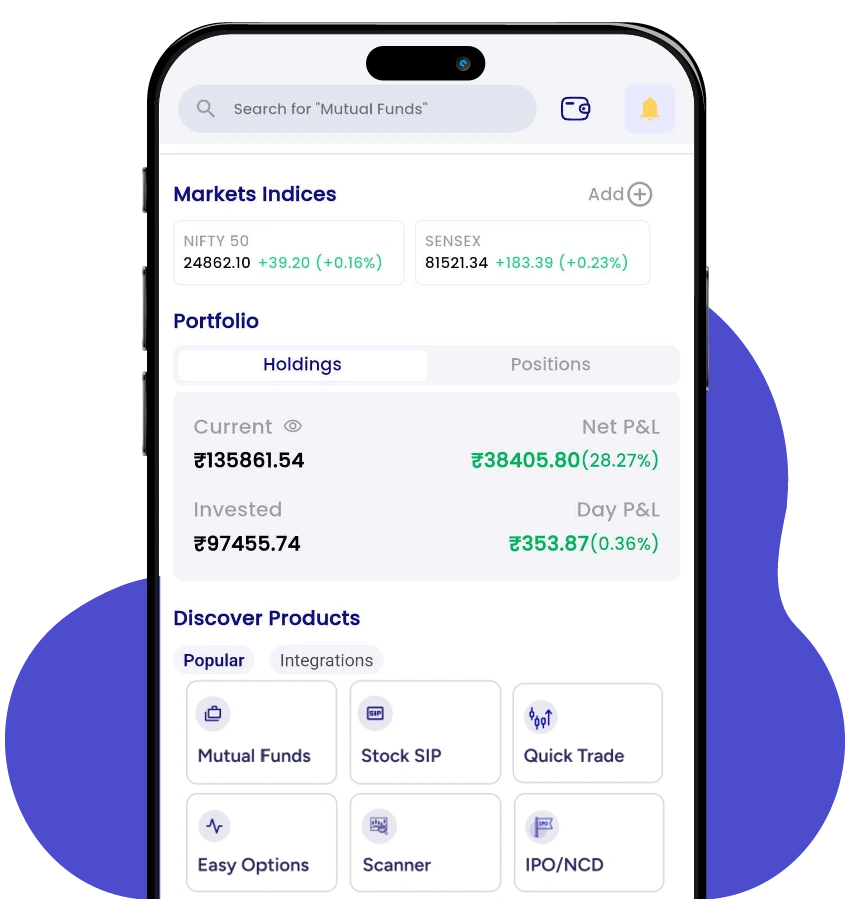What is a Call Option?
- 17th July 2025
- 10:45 AM
- 10 min read
Imagine locking in your preferred stock today and paying for it only if its value rises; this is the power of a call option. A call option gives you the right, but not the obligation, to purchase an underlying asset like stocks, bonds, or commodities at a predetermined price on or before a specific date.
If the market price exceeds this strike price, you can buy low and sell high to generate profit. With India’s futures and options market witnessing an average daily turnover of INR 229 trillion, understanding call options is crucial for modern investors. Learn more with real examples.
What Does Call Option Mean?
A call option is a type of financial contract that gives you the right, but not the obligation, to buy an underlying asset, such as a stock, bond, or commodity. You can buy the asset at a predetermined price, known as the strike price, before a specific expiry date.
Moreover, you have the flexibility to choose the number of units you want to purchase. If the market price of the asset rises above your strike price, you can exercise the call option and earn a profit. However, if the price does not rise above your target, you are not obligated to buy, and your maximum loss is limited to the premium paid.
A Detailed Example of a Call Option
When the market sentiment is bullish, it indicates the market is going upward, and traders opt to exercise their call options to reap benefits.
For example, a company is selling their shares for INR 100. Setting a target or strike price of INR 105, you buy 50 shares of this company at a premium of INR 3, speculating that its price would increase after 1 month.
If stock prices rise to INR 120 next month, you will earn a profit of INR 600 and here is how you will earn it:
- Spot Price – Strike Price = 120-105 =INR 15
- Total gain= INR 15*50= INR 750
- Paid premium = INR 3*50= INR 150
- Net profit = INR 750 – INR 150 = INR 600
Long vs. Short Call Options
Now that you have an idea about what is a call option is, let us dive into the difference between a long and short call option:
-
Long Call Option
You can think of a long call option as a bet on the stock pricing of a particular underlying asset, like a stock, bond, commodity, etc. Therefore, when you opt for a long call option, you set a strike price and wait for stock prices to rise within the expiry date of the option.
Now, if stock values rise within that timeframe, you can purchase it at a lower price and also choose to sell it to make an immediate profit.
If you are planning to exercise a call option and earn profit, look no further. PL Capital Group – Prabhudas Lilladher is the ideal choice for this type of trade. Download the PL Capital app today!
-
Short Call Option
A call option can also be used in a bearish market through a short call strategy. This approach is ideal when you expect an asset’s price to decline. It allows you to earn upfront premium income, helping offset your margin.
For instance, if an investor believes a stock will not exceed INR 53 in the next month, they can sell a call option at that strike price for 100 shares, earning INR 2 per share (INR 200 total). If the price stays below INR 53, they keep the premium. If it rises to INR 55, the loss equals the premium, resulting in no profit or loss.
Difference Between Call and Put Options
After understanding the call option meaning and types of it, let us understand how it is different from a put option:
-
Direction of Profit
When you purchase a call option, you expect the market price of your chosen underlying asset to rise. Contrarily, for put options, you sell an underlying asset at a predetermined price. This selling price will be higher even when the market value of that asset is low.
-
Profit Timing
You gain profit when the asset price exceeds your set target or strike price in a call option. However, in the put option, you will realise profits when the asset prices are down.
-
Profit Limit
If you prefer a call option, there is no upper limit to profit if the stock prices rise significantly. However, in the case of a put option, the profit is limited. This is because a decrease in asset price will ultimately be stuck at zero.
-
In-the-Money (ITM) and Out-of-the-Money Conditions
In a call option, the ITM condition happens when the spot price of the asset is higher than the strike or target price. In the put option, when the spot price is lower than the strike price, it is called an ITM condition. OTM in call options take place when the spot price is lower than the strike price. For a put option, it is the condition when the spot price is higher than the strike price.
When Should Investors Buy a Call Option?
The short answer is ‘when the market sentiment is bullish’. After learning the call option definition and its difference from a put option, you must learn when to buy a call option for an informed decision. If you plan to sell your call option, you must wait for market conditions to be favourable for profit.
Therefore, whenever the market sentiment is bullish, buying a call option is the right move. One of the key strengths of this option is that profit from the assets is unlimited. This is because there is no limit in theory on how much a stock price can go up.
You might also think of the situation if the stock prices do not rise above the strike or target price. This is extremely common in a volatile market like the stock market. For example, recently, companies listed in the Indian stock exchanges lost about INR 19 lakh crore in value. Such situations affect the growth of underlying asset values.
However, one of the benefits of such a call as an option is that the loss is limited. If the market moves downwards unexpectedly, your losses will be only the premium amount, limiting your losses.
When Should Investors Sell a Call Option?
Buying a call option is a smart strategy when you expect asset prices to rise. However, if you anticipate a potential price drop, selling the call option can be more suitable.
When it comes to selling, you have two approaches to choose from: covered and naked call options, each with its own risk and reward profile.
-
Covered Call
Suppose, as an investor, you already own a stock and sell your call option on it to another investor. You do this in return for premiums. This way, you can earn a low-risk profit from the premium even if stock prices do not change much.
However, if the stock price rises sharply, you will miss out on gains. This is because you must sell the agreed stock at your set strike price and not the new or higher price.
-
Naked Call
You can opt for a naked call option when you agree to sell a call on an asset you do not currently own. This strategy carries a higher risk.
If the asset’s price rises and the buyer exercises the option, you will be forced to purchase the asset at the market price and sell it at the lower strike price, resulting in a loss. To offset this risk, sellers typically charge a higher premium, which becomes their potential profit, only if the option expires without being exercised.
Factors Influencing the Price of the Call Option
There are several factors that influence the call option price in the market. Here are a few of them:
-
Intrinsic Value
The intrinsic value of an option is the difference between your strike or target price and the underlying asset value. In the case of ITM options, the intrinsic value is positive, and OTM calls do not have any intrinsic value. A higher intrinsic value indicates a higher premium.
-
Volatility
When you opt for a call under option trading, you speculate on the market movement. This is to determine the value of an underlying asset. Thus, a higher market volatility indicates a higher premium, as it also increases the chance of an option being profitable.
-
Rate of Interest
Interest rate is another important factor influencing the price of such an option. With the rise in interest rates, the option’s value also rises. A higher interest rate increases the cost of holding or carrying underlying assets and makes a call option more attractive.
-
Time to Expiry
The time until expiry plays a key role in call option pricing. Options with longer expiry periods usually carry higher time value, as they allow more opportunity for the asset price to move favourably. An example is Long-Term Equity Anticipation Securities (LEAPS), which can have expiration dates of up to three years, offering extended potential for profit.
Conclusion
A call option is a financial contract that gives the buyer the right but no obligation to buy underlying assets at a set price and on a date. The benefit here is that if the market moves upwards, you should exercise the call as an option. You can acquire the right to buy an asset at a price before its price increases, and purchase it at a lower cost.
With PL, you can also reap investment benefits from options trading by investing in derivatives. Download the PL Capital app today!
FAQ’s
1. How do call options work?
A call option is a financial contract between an investor and the seller, where the buyer gains the right, but not the obligation, to purchase an underlying asset at a predetermined price on or before a specific date.
2. Why would you buy a call option?
You should buy this option for underlying assets when you can anticipate that prices will rise. Thus, you become profitable by purchasing assets at a lower price if the market price of these assets rises.
3. Is buying a call bullish or bearish?
Investors buy this option and exercise it when there is an anticipated rise in the price of assets. This is a bullish strategy from an investment perspective.
4. Who benefits from a call option?
Investors often use this option strategy to make a profit out of a price increase of assets without owning them. If asset prices increase, investors buy the asset at a lower strike price.





